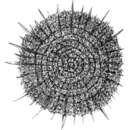en
names in breadcrumbs


Spongodiscidae is a family of radiolarians in the order Spumellaria. According to the original description by Ernst Haeckel, members of the family have a flat discoidal shell, in which a simple spherical central chamber is surrounded by an irregular spongy framework.[1]
Spongodiscidae is a family of radiolarians in the order Spumellaria. According to the original description by Ernst Haeckel, members of the family have a flat discoidal shell, in which a simple spherical central chamber is surrounded by an irregular spongy framework.